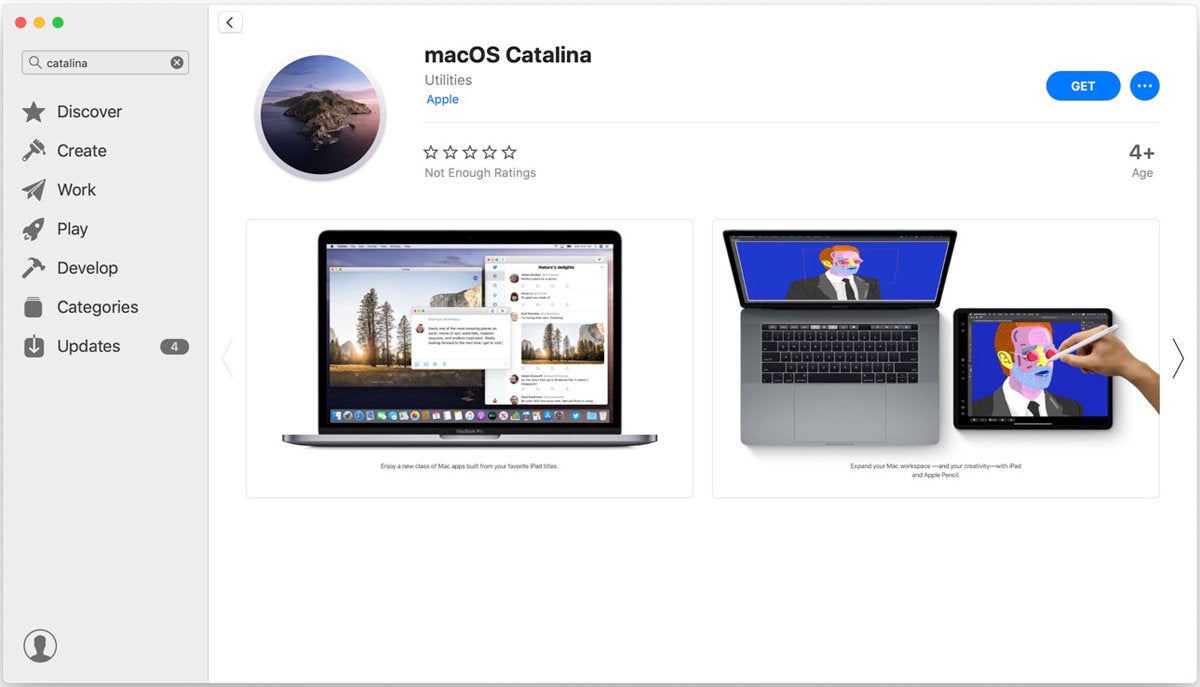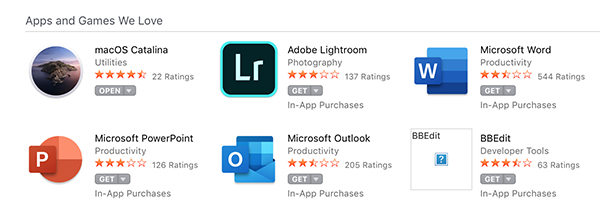An external drive that you can use as an installer for macOS Catalina is a handy thing to have. If you have multple Macs to upgrade, it’s a lot more efficient to plug in the USB installer drive and run the installer than to log into the App Store, download the 8.09GB OS installer, and then run it.
In this article I’ll go over the different ways you can create a bootable macOS Catalina installation drive. But before I give instructions on how to create the drive, I’ll go over the items you’ll need and how to get them.
Get an external drive and maybe an adapter
The macOS Catalina installer software is over 8GB, so you need a USB external drive that can hold that much data. The drive can be a thumb drive, hard drive, or SSD.
If you have a 2015 or newer MacBook or a 2016 or newer MacBook Pro, you may need Apple’s $19 USB to USB-C adapter. This will allow you to connect a storage device that uses a USB type-A connector. If you don’t have an external drive and you have a USB-C Mac laptop, you could buy the SanDisk Ultra USB Type-C Flash Drive, which has a USB-C connector. You can get model number SDCZ450-016G-G46.
When creating the boot drive, the storage device is reformatted, so there’s no need to format the drive beforehand.
Get the macOS Catalina installer software
The macOS Catalina installer is available in the App Store. If you launch the App Store app, do a search for “Catalina.” Or, if you click this Catalina App Store link, it will take you to the Catalina App Store webpage, then click on the “View in the Mac App Store” button.
You can read the information to learn more about Catalina. When you’re ready to download the software, click the Download button. (If you’ve already downloaded the installer, the button will say Install instead of Get.)
Once the download is complete, the installer will launch automatically. But don’t continue with the installation. Instead, press Command-Q on your keyboard to quit the installer.
- Similar to Mojave, if you can get it to install and boot, sure, there is no reason you can't -run- Catalina from an external USB-C drive. Given the hiccups involved w/Mojave, however, I'd not bother. If you need to include an external, try parking your Home folder on it, instead, and use FUS to get in.
- The macOS Catalina installer is available in the App Store. If you launch the App Store app, do a search for “Catalina.” Or, if you click this Catalina App Store link, it will take you to the.
The Catalina installer app will be in your Applications folder, so you can go there and launch it later to upgrade your Mac to the new operating system.
Make a bootable installer drive: The quick way
Apple Bootable Usb Catalina 3.0
I used a free app called Install Disk Creator to make the installation drive. Download Install Disk Creator by clicking on the link. When the download is done, you can move it over to your Applications folder. Then follow these steps to create your bootable macOS Catalina drive.
Step 2: Create macOS Catalina Bootable Installer. To create a macOS Catalina Bootable Installer file, we will be using Terminal from the Applications with the help of a macOS Catalina Installer File. Now, insert your USB drive or the external drive into the USB port. Before proceeding with the installation, we need to format the USB drive.
1. Connect your drive to your Mac.
2. Launch Install Disk Creator.
Basically, older Mac OS X CD's have two main partitions. One with the main install (HFS+) and another one with Boot Camp drivers for Windows (FAT32 or just a standard CD format). If you look in the ISO or DMG in the archive.org explorer, it can't read HFS+, only the standard, FAT32 or CD format. That's why it seems like there are only. Mac os x iso download 64 bit torrent.

3. In the main window, you’ll see a pop-up menu under Select the volume to become the installer. Click on the menu and select your drive.
4. Under the pop-up menu, you’ll see Select the OS X installer. (macOS used to be called OS X.) If you have only the Catalina installer on your Mac, Install Disk Creator will automatically select it. If you have other macOS installers, you need to click on Select the OS X installer and select the Catalina installer.
5. When you’re ready, click Create installer. Your Mac may tell you that Install Disk Creator wants to make changes, and you need to enter your user name and password. After you do this, the app will take a few minutes to create the boot drive. A progress bar. appears at the bottom of the Install Disk Create window.
If you try to start the process and you get a failure message saying that the drive couldn’t be unmounted, try reformatting the drive first as ExFAT using Disk Utility. Then start the process over again.
When the app is done, the installer is ready to use.
macOS Catalina is a hugely exciting upgrade for the Mac. In some ways, it’s like having a completely new computer. You may have already taken the plunge and installed it, or maybe you’re waiting to see how it settles down before you install it. But whichever camp you’re in, it’s a good idea to create a bootable installer for macOS Catalina. That way, if anything goes badly wrong with your Mac, you’ll be able to boot from the installer and get going again quickly.
Why do I need a bootable installer for macOS Catalina?
There are a number of reasons for creating a bootable USB Mac installer.
- If you have more than one Mac, it allows you to install Catalina on all your other Macs without having to download it from the App Store each time.
- You may want to clean install Catalina, in which case you’ll completely wipe your startup disk and will need to boot from an external drive to do that.
- It’s good protection against a catastrophe striking your Mac’s startup disk, especially if you don’t have a stable internet connection. Normally, if you need to reinstall macOS, you can just boot from the recovery partition and do it from there. However, that means re-downloading the installer. So, if you don’t have an internet connection or it’s very slow, you need an alternative.
What should I use as a bootable installer?
You can use an external hard drive, an SSD or a USB stick. Anything that has at least 16 GB of free space. Cracked illustrator mac reddit. You’ll need to create a new partition (or container if it’s formatted as AFPS) for the installer so if you have data on it you need, you should copy it to another drive first.
How to create a bootable USB drive for macOS Catalina

Apple Os Catalina Usb Bootable
Whoa! Not so fast. There’s one more thing you should do before you create the installer: clear out the junk on your Mac. Before you undertake any major task on your Mac, and especially before you install a new version of the operating system, you should clear out junk and old files you no longer need. I don’t normally recommend software tools, but in this case, the nest way to clear out the clutter is to use CleanMyMac X. It can scan your Mac at the press of a button, identify all the files you don’t need, and allow you to get rid of them with one more click. Here’s how to use it:
- Install, and launch CleanMyMac X — download a free edition here
- Choose Smart Scan from the list of utilities in the sidebar.
- Press Scan.
- When it’s finished, press Run to delete files immediately, or Review Details to see what it has found.
Once you’ve cleared out the clutter, you can go ahead and create your bootable installer. Here’s how:
- Launch the App Store app and search for macOS Catalina. (If you’re reading this before Catalina has been launched, you’ll need to use the public beta. You can sign up for Apple’s public beta program and download it here Apple Beta Software Program)
- When the results appear, click on Catalina, then click ‘Get’.
- Wait for it to download. When it’s finished, the installer will launch. Quit it immediately.
The installer has now been saved in your Applications folder. You can go ahead and check, if you like. You now have two options for creating the installer. If you’re comfortable with using Terminal, you can go ahead and jump to the instructions for that, below. If you’d rather not use Terminal, there’s a neat utility called Diskmaker X that will do it for you. All you need to do is download and install it and then, when you run it, point it to the macOS Catalina installer you just downloaded. There are full instructions on the download page.
How to create a bootable installer using Terminal
- Plug the USB stick, hard drive or SSD into your Mac.
- Go to Applications>Utilities and double-click Disk Utility to launch it.
- Select the disk you want to use for the installer and choose the Erase tab.
- Choose APFS or Mac OS Extended (Journaled) as the format and choose GUID partition map from the options, if it’s available.
- Give the disk a name and press Erase.
- When it’s finished, quit Disk Utility.
- Go to Applications>Utilities and double-click Terminal to launch it.
- Type:
sudo /Applications/Install macOS Mojave.app/Contents/Resources/createinstallmedia —volume /Volumes/Untitledwhere ‘Untitled’ is the name of your USB stick or external hard drive
- Press Return and wait for the word Done to appear in Terminal.
- Quit Terminal
You now have a macOS Catalina installer on an external disk or USB stick. Eject it, unplug it and keep it safe. You can use it to install Catalina on any Mac that supports it.
One more step: update applications
Once you’ve used tour new installer to install Catalina on a Mac, it’s a good idea to update all your applications so that that are Catalina compatible. You can do this manually, from the App Store and by launching non-App Store apps and choosing check for updates, but that’s a long and tedious process. It’s much quicker and easier to use the updates in CleanMyMac X. Here’s how you do it.
- Launch CleanMyMac X.
- Select the Updater tool in the Applications section.
- Press Select All.
- Press Update.

And that’s it. You’re done. CleanMyMac X checks all your installed apps for updates and then updates them all.
Creating a bootable installer for macOS Catalina isn’t difficult. If you have a spare disk or USB stick and are comfortable using Terminal, you can do it right away. If you’d rather not use Terminal, use the Diskmaker X tool described above. Whichever method you use, make sure you use CleanMyMac X to clear out the junk on your Mac before you start, and use it again to update your applications when you’ve finished.
